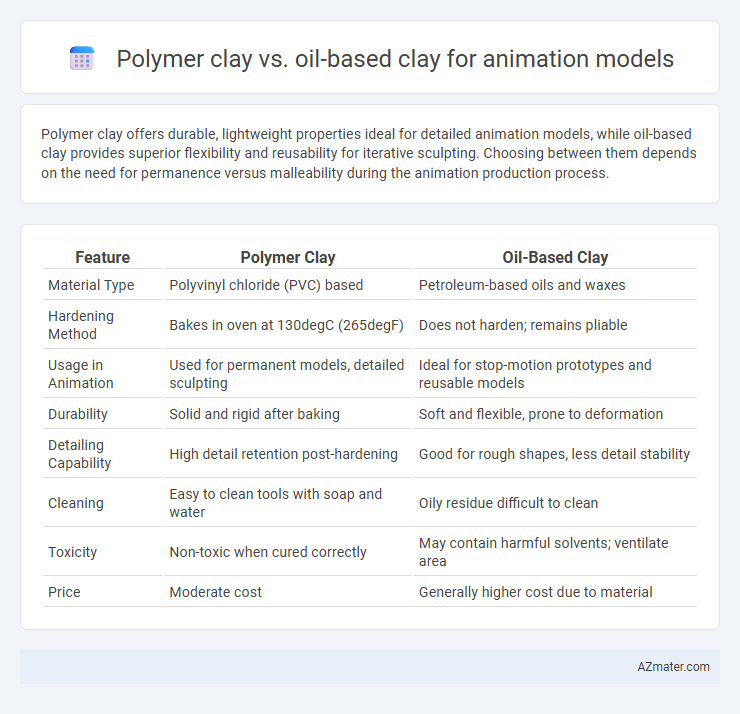Polymer clay offers durable, lightweight properties ideal for detailed animation models, while oil-based clay provides superior flexibility and reusability for iterative sculpting. Choosing between them depends on the need for permanence versus malleability during the animation production process.
Table of Comparison
| Feature | Polymer Clay | Oil-Based Clay |
|---|---|---|
| Material Type | Polyvinyl chloride (PVC) based | Petroleum-based oils and waxes |
| Hardening Method | Bakes in oven at 130degC (265degF) | Does not harden; remains pliable |
| Usage in Animation | Used for permanent models, detailed sculpting | Ideal for stop-motion prototypes and reusable models |
| Durability | Solid and rigid after baking | Soft and flexible, prone to deformation |
| Detailing Capability | High detail retention post-hardening | Good for rough shapes, less detail stability |
| Cleaning | Easy to clean tools with soap and water | Oily residue difficult to clean |
| Toxicity | Non-toxic when cured correctly | May contain harmful solvents; ventilate area |
| Price | Moderate cost | Generally higher cost due to material |
Introduction to Animation Model Clays
Animation model clays, essential for stop-motion and character design, vary primarily between polymer clay and oil-based clay. Polymer clay, known for its hardening properties when baked, offers durability and fine detail retention, making it ideal for permanent models. Oil-based clay remains pliable without drying, allowing continuous reshaping and refinement, perfect for iterative animation sculpting.
Understanding Polymer Clay
Polymer clay is a versatile, oven-bake material known for its durability and fine detail retention, making it ideal for animation models that require precise articulation and long-lasting stability. Unlike oil-based clay, which remains soft and prone to deformation, polymer clay hardens permanently after curing at around 265degF (130degC), allowing animators to create consistent, reusable character poses. Its wide range of colors and compatibility with painting or sanding post-bake enhances customizability and professional finish in stop-motion animation production.
Exploring Oil-Based Clay
Oil-based clay offers superior malleability and longer working time compared to polymer clay, making it ideal for detailed animation models requiring frequent adjustments. Its non-drying nature ensures models remain pliable throughout the entire animation process, allowing animators to create smooth, incremental movements without the need for re-sculpting. Popular brands like Plastilina provide consistent texture and durability, essential for stop-motion animation and complex character posing.
Workability and Sculpting Techniques
Polymer clay offers excellent workability with its firm yet pliable texture, allowing detailed sculpting and fine surface finishes ideal for stop-motion animation models. Oil-based clay remains soft and flexible without drying, enabling continuous reshaping and advanced techniques like additive and subtractive sculpting, but lacks the durability for long-term handling. Choosing between polymer and oil-based clay depends on the balance between permanence and the need for iterative adjustments during the animation production process.
Baking and Curing Processes
Polymer clay requires baking at temperatures typically between 230degF and 275degF (110degC to 135degC) for about 15-30 minutes per 1/4 inch (6 mm) thickness to harden, offering a rigid, durable finish ideal for stop-motion animation models. Oil-based clay remains pliable and does not cure through baking, necessitating alternative support methods such as armatures or silicone molds for stability during animation. The baking process of polymer clay enables easier handling and long-term preservation, whereas oil-based clay's flexibility allows for repeated reshaping without structural compromise.
Reusability and Flexibility
Polymer clay offers limited reusability as it hardens permanently when baked, making it ideal for detailed, static animation models but unsuitable for repeated reshaping. Oil-based clay remains pliable and reusable without drying out, providing superior flexibility for continuous adjustments and dynamic pose changes during animation production. The choice between polymer and oil-based clay hinges on whether permanence or ongoing malleability is essential for the animation workflow.
Durability and Longevity
Polymer clay offers exceptional durability for animation models, hardening permanently after baking, which ensures long-lasting structures resistant to wear and environmental factors. Oil-based clay remains pliable and reusable, providing flexibility during the animation process but lacks long-term stability, as it does not cure or harden over time. For projects requiring enduring, stable models, polymer clay is preferable, while oil-based clay suits iterative, short-term sculpting needs.
Surface Detail and Texture Quality
Polymer clay offers finer surface detail and sharper texture quality due to its ability to harden permanently after baking, allowing for intricate sculpting and long-term preservation of delicate features. Oil-based clay remains pliable and does not dry out, providing smooth blending and subtle texture transitions, but it lacks the permanence needed for capturing fine details long-term. Animators often choose polymer clay for detailed model finishes, while oil-based clay suits early-stage adjustments and flexible texturing.
Suitability for Animation Workflow
Polymer clay offers excellent suitability for animation workflows due to its ability to harden permanently after baking, ensuring stable character models that maintain fine details during stop-motion filming. Oil-based clay remains pliable and never fully hardens, allowing animators to easily reshape and reuse models for dynamic pose adjustments but may risk deformation or dust accumulation over time. Choosing between polymer clay and oil-based clay depends on whether the workflow prioritizes permanent, durable models or flexible, reusable sculpting for iterative animation processes.
Cost and Availability Comparison
Polymer clay typically offers a lower cost per pound and is widely available in craft stores and online retailers, making it an economical choice for animation modelers on a budget. Oil-based clay tends to be more expensive upfront but remains reusable after sculpting, reducing long-term material expenses despite limited availability primarily through specialty suppliers. The choice between polymer and oil-based clay hinges on balancing initial cost constraints with the desire for material longevity and ease of procurement.

Infographic: Polymer clay vs Oil-based clay for Animation model
 azmater.com
azmater.com